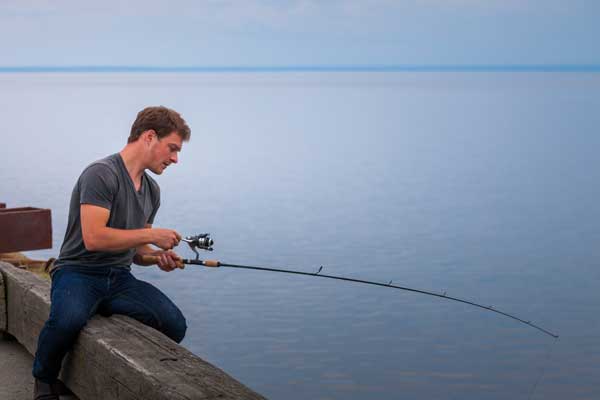How to Fish for Striped Bass [Beginner Guide]
Fish or striped bass requires great techniques. This is to fully take advantage and retrieve more active stripers. The expedition to yielding a successful catch of striped bass starts by knowing how to fish.
Even though there are many techniques to implement while fishing. Some remain to be the most effective in nearly all seasons.
Learning How to fish for striped bass, will equip you for all baitfish schools. Whether in the shallow waters or the deep waters, you will have an edge.
For that purpose, this article will teach you everything you need to know to fish striped bass as well as other types of fish.
What Are Striped Bass?
The striped bass is a unique species of bass that is commonly found on the North American coast. As the name suggests it has dark longitudinal stripes that distinguish it from other basses.
The stripes run from beneath the gills to the tail. They feature a streamlined and silvery body that makes them easily spotted in clear waters.
They are also referred to as stripers or rockfish. The name striper is attributed to their stripes, whereas, the name rockfish is due to their tendency to nestle on rocky habitats.
Nicknamed the nomads of the inland sea, they can move many miles in search of food.
They grow up to 5 feet long with a maturity mass of 9-18 kg (20 – 40 pounds) and live up to 30 years.
Many anglers find this bass as one of the difficult fish to catch. Is that true?
Yes, the stripers are indeed difficult to catch. This is especially during the summer when they are less aggressive to the baits, and hunting for them is not a thought.
To at least make a catch you need to handle cast the hook and the bait carefully. But, at least this can be an advantage because they cannot be overfished.
Little History About Striped Bass
The history of these bass dates back to North America, where significant fishing activities were carried out. This was during the colonial period when large stripers schools were seen along the coastlines.
In later years they have been introduced in the Pacific Ocean and other major reservoirs, mainly for recreational purposes. There has also been a significant introduction of stripers in aquaculture across different states.

During the 1990s the striped bass had increased in large numbers, putting them a great risk. This is because the large numbers meant they needed to feed on more herring and shad, which could result in a lack of food in the future.
The largest rockfish to be caught netted a record 37.14 kg (82 pounds) in 1896. This edged out a 78.8-pound record fish caught in the year 1982.
Differences Between White bass
The rockfish mainly resembles the white bass in many ways. These two species generally live in the same water and the markings on their bodies are less the same.
There is even a cross hybrid of the two referred to as the Hybrid striped bass.
Even with the right techniques distinguishing these two basses can be a great hindrance to an angler’s success. That is why you need to know how to distinguish the two in a given situation.
Here are some of the features you can use to figure out the differences:
- The white bass has a round body shape, unlike the striped bass that has a slender body.
- White bass has one tooth patch in their mouth, contrasted to the two patches in the rockfish.
- The stripers have distinct-strong and clear stripes, whereas the white bass has faint stripes.
- In the white bass, only one stripe reaches the tail, but in the striped bass, there are several of them.
Pretty much in most situations, you get hold of a bass that resembles the two, the above features will help you get straight to which is which.

Further Reading
Where Do Striped Bass Like To Hang Out?
The stripers like to hang out in different places at different times of the year. This majorly depends on the availability of food, the season, and the water depth.
When they are young they spend their lives in the fresh and shallow waters (like rivers), which change to saltwater when they mature. They will then spend their entire life shifting to different waters.
During the summer and the autumn season, they will move to the saltwater in large schools down the stream into saltwater. This is major because of two reasons; one is to seek shelter from the direct sun and the other is to find more food.
Due to the temperature rise during summer food becomes scarce in the shallow waters, as their prey (shads and herring) hide from the sun.
Angling in the freshwaters will yield very low results, with a fewer number of fish that are less aggressive to lures (baitfish school). But you can use the bloodworm types of bait which works best in this environment.
When the fall season is coming to an end, a large school of stripers will be sported moving up the stream back to the freshwaters. They spend their time here for the next two seasons the winter and the spring season.
Here hunting becomes very easy in these shallow waters.
Casting your bucktail here can yield fruitful results. When the temperatures go down they move beneath to avoid the top parts.
But in some cases, the bass remains at one part of the bay. This is especially when there is a lot of food in all the seasons, they will remain there most of the time, and you can spot them in large numbers.
When it comes to the larger stripers they will enjoy hanging in different parts of the ocean.
What Do I Need For Striper Fishing?
Like any other type of fishing, you will need to have the necessary tools for striper fishing. This ranges from the protective gears, lures, casting rod hooks, and other important items.
This will help you as an angler get more positive results. For that case here is a detailed list of things you need for striper fishing.
1. Reel
Having a good reel will ensure you can pull your target promptly from the water. You should not chip out your cash on just any reel. Make sure you can rely on the reel you choose for use in any environment.
Don’t go for cheap reels which are usually not effective. Yes, you will buy many reels when they are cheap, but of what benefit will that be if they are faulty.
With $30.00 or more bucks you can get a good reel.

Just visit your nearest fishing accessories store, and be sure to get several of these combos.
It’s worth paying more for a decent reel. It is recommended you buy your reel and rod separately.
2. Right Striper Rods
Quality striper rods are useful for every angler. They go hand in hand with a reel. They come in different types depending on several conditions like the type of lures and the fishing style being used. When choosing a rod look at:
- Length of the rod
- Lure weights
- Type and sharpness of hooks
3. Lures
This is where you need to spend more money. Because the bait lures will determine many things in your fishing adventure. If you can access live baits like bloodworms and bucktails the better.
They are more effective to lure rockfish. Artificial baits are also not that bad to use. The common ones are soft baits, jig, Simmers, and topwater plugs.
Then you should also have lure storage containers to store your lures.
4. Line
In the past choosing, a line was a very simple task. An example like mono was all you needed. But, in this new age of striper fishing lines like braid are good.
This is because they have a high stretch, a large diameter, and also have great sensitivity. This makes them sought after casting lines, even when on a boat it works well.
Examples of braids you can use are; PowePro, Daiwa J Braid & Sufix 832.
When using a fishing braid it is good to use it with a leader. The two common fluorocarbon leaders you can use are; Sea guar Blue Label and Yo-Zuri H.D. Carbon.
Then you also need to be equipped with the necessary techniques. This is to increase the amount of output.
Best Techniques for Striped Bass Fishing
In your fishing adventure, you come across a great school of bass within your casting. They are feeding aggressively, and your mind tells you this is a perfect moment for a catch.
After a few attempts, your efforts hit a dead end.
You get stressed about where you may be going wrong. You think it’s the equipment you are using, but after cross-examination, they are working well.
You even change lures but still nothing to show for it. At this point, it is evident you are not incorporating these important techniques.
Be Speedy
Speed is a key technique every fisher should possess. Speedy strikes and speedy retrieval of the lures produces better results.
Fast retrieval keeps the bass away from inspecting the lures. It also causes aggression of the bass, leading them to detect the presence of prey. The key is that even with high speeds the lure maintains its swimming position.
In such a case lures spinning at high speeds shouldn’t be employed. Stripers also like to attack fast-moving lures.
Match the Hatch
You should be matching the hatch in all cases of striped bass fishing. This is a trickery technique that is used to match artificial lures to the natural food of the bass.
This details choosing lures that have similar sizes, colors, and shapes to the feeds. After that ensure you simply present the bait to avoid distracting the fish.
Furthermore, avoid casting your image on the water. This will yield up to 3 times of success.
Observe The Season
One of the most important skills possessed by any angler is observation. This is vital in observing the seasons. During the fall and summer season, you are more likely to fish more in the deep seas, where the fish are hiding.
In the shallow water, they will not attack the bait aggressively.
When it comes to the spring and winter the advantage shifts to the shallow freshwaters. Large schools of stripers are busy feeding and will confuse baits for food.
In all seasons take the opportunity to Fish in the early morning and the evening when the fish feed more.
Live Lures Work Magic
Using live lures will yield more. Talk of shads, panfish, and minnows, just to mention a few are some of the best live baits you can get. They are very good when it comes to attracting the fish to make bait.
Research is done by Embrapa researcher live lures yields up to 50% more results compared to artificial lures.
But the best practice is to match artificial lures to live baits.
Final Thoughts
The stripers are one of the few fish species that will survive in both saltwater and freshwater. Fishing for stripers is a great fun activity and that is why knowing how to fish them will make for a successful fishing trip.
For that, the above tips will benefit your angling career for hungry striper bass.
Related Questions
What is the best time to fish for Striped bass?
The best time to fish for stripers is early in the morning hours and very late in the evening. These are the times when the bass is usually busy feeding.
Are striped bass bottom feeders?
Yes, the large striped bass is a great bottom feeder. There, they get meals of crabs, lobster, and flounder, which are one of the bass’s favorite food.



